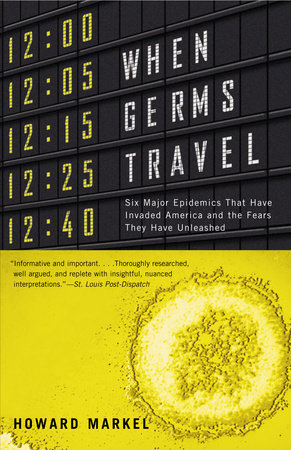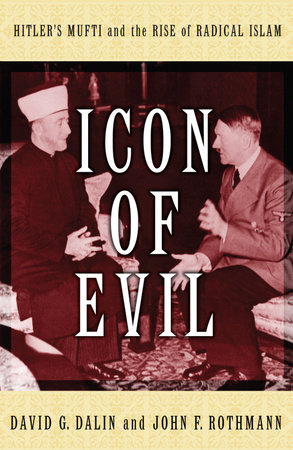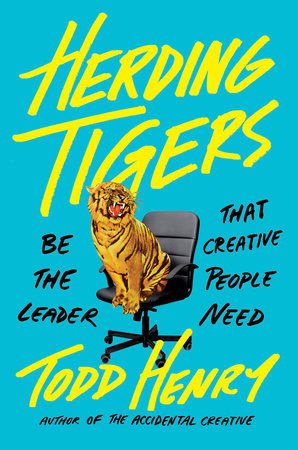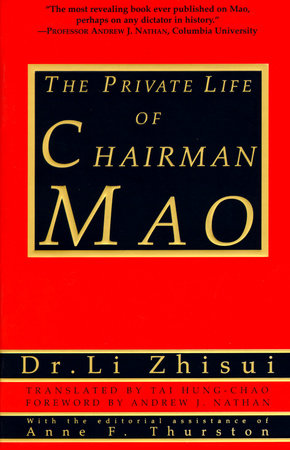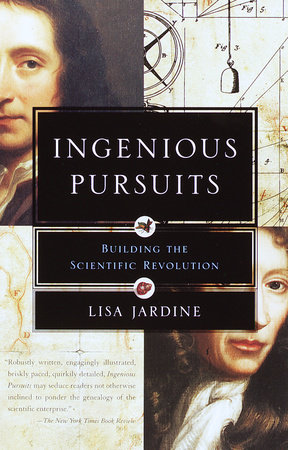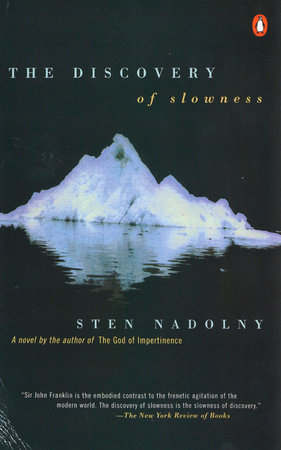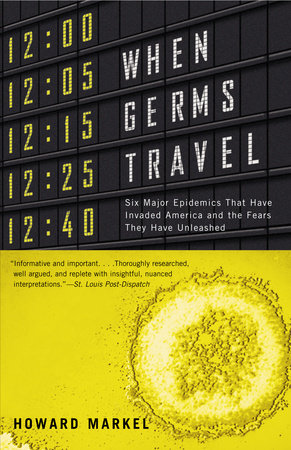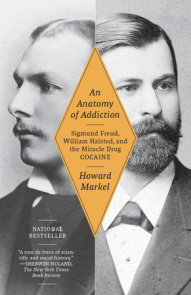Author Q&A
A Conversation with Howard Markel
Q: Over the past century, so many new contagious diseases have reached epidemic proportions. What led you to investigate the six epidemics detailed in WHEN GERMS TRAVEL?
A: For almost twenty years, I have both practiced medicine and studied the history of medicine and public health. All of this work has forced me to conclude that, without question, the major health threats facing humankind today are contagious, epidemic diseases. This is because we live in a world of deadly germs that travel freely and widely. Given the remarkable pace of international transportation and the burgeoning rate of human migration around the globe, we are at serious risk for a return to the type of global pandemics that have not been seen in almost a century.
Q: But why look to history? Why not look to the future?
A: Over the past several decades doctors have been remarkably successful in identifying the microbial causes of specific infectious diseases, creating miraculous medicines, such as antibiotics, that can treat many of these scourges, and developing vaccines that prevent some contagious diseases before they ever have a chance to strike. Yet thereï¿*s a dangerous paradox to these successes in that the best public health programs are silent in nature. When the system is working well, few diseases break out and those that do are quickly contained. These very successes, however, lead us to become overconfident that germs have been conquered. But, of course, we never really conquer germs. We merely wrestle them to a draw. Or to put it another way, the complex dance between these living beings, humans and microbes, is eternal. What changes from era to era is which living being is actually leading in that dance. Since the advent of antibiotics during the 1950s, especially, human beings have appeared to be in control but over the past few decades the germs have evolved to outwit our best attempts to annihilate them.
But merely citing scary statistics of the incidence of disease is not enough to alert Americans about the global threat of contagion. All of usï¿*from doctors to patientsï¿*are better able to understand and relate to these dangers when hearing about epidemics as they affected the lives of real people. These stories of six epidemics that invaded the United States between 1900 and 2001 are driven by conflict, panic, contention, bravery, scientific discovery, brilliant detective work, and detail lives that were markedly altered because of a chance meeting with a deadly microscopic organism.
Q: Tell me some of the most interesting things you learned and report upon?
A: To begin with, there are far many more similarities in how Americans have responded to epidemics over the past one hundred years than differences. Most troubling, we have repeatedly searched for a scapegoat, either an individual or a social group that the majority of Americans have deemed to be ï¿*undesirableï¿*, to blame for a particular outbreak. Across time there have been many different candidates for this dubious distinction such as the urban poor, African-Americans, and, more recently with the AIDS epidemic, gay men. But one of the most consistent scapegoats for the importation of infection onto American soil over the past hundred and fifty years has been the immigrant. The nationalities of these immigrants have changed with each generation, from Chinese and East European Jews at the beginning of the twentieth century, to Haitians accused of importing AIDS and Rwandans thought to carry cholera germs at the centuryï¿*s close. At the same time, we Americans are quite adept at failing to ameliorate those conditions that give rise to many of these diseases in the first place. We also tend to forget that microbes are quite egalitarian in their mode of attack and are the least prejudiced of living beings.
Q: How are the epidemics of the early 20th century different from those we see today?
Specific epidemic diseases that frightened Americans of one era are hardly given a second thought in another. For example, trachoma, the dreaded eye infection that continues to rob more than 10 million people of their sight each year, was considered the number one imported health threat of the early 20th century. Indeed, the U.S. government invested millions of dollars in creating the U.S. Public Health Service and vast inspection factories such as the famed Ellis Island to insure that diseased immigrants did not enter the United States where they might harm unsuspecting American citizens. Similarly bubonic plague and cholera were among the most dreaded contagious diseases of the late 19th centuries, and with good reasonï¿*these microbes managed to kill millions of people as they traveled around the globe. Yet today, most of us consider these still active scourges to be relics most reliably found in a dusty, old medical textbook or a museum.
But what was most exciting for me to learn about and report on were the lives of the individuals who make up these stories of imported infection and their harrowing encounters with deadly and contagious diseases: a Chinese immigrant in San Franciscoï¿*s Chinatown in 1900 who was accused of spreading bubonic plague; an East European rabbi with trachoma who was detained at Ellis Island in 1917; a group of Mexican women who staged a riot at the Texas-Mexico border when they were erroneously accused of harboring typhus fever at the height of Pancho Villaï¿*s revolution; and more recently, Haitians who escaped death in their own country in the 1990s only to be handed a death sentence in the form of positive HIV tests and incarcerated on the U.S. Naval Base at Guantanamo, Cuba; Rwandan refugees living in Detroit during the late 1990s suspected of bringing cholera into the United States; and immigrants settling today in New York City with active tuberculosis.
Q: You discuss trachoma, bubonic plague, tuberculosis, AIDS, cholera, and typhus fever. What can you tell us about these diseases that we probably wouldnï¿*t otherwise know?
A: Ironically, most of my medical students donï¿*t know much about many of these diseases, so I suspect that all of us, regardless of our level of medical knowledge, have much to learn about some of the leading contagious killers of the past century. All of the microbes described in WHEN GERMS TRAVEL are remarkably different from one another, how they live, reproduce, and attack the body. Doctors like me are, of course, fascinated by the inner workings of disease and I had great fun developing engaging and exciting descriptions of these infections that I hope will enthrall and enlighten the reader.
Every infectious diseases described in the book has a wonderful history including how it altered and affected human society, what the modern study of microbiology and genetics can tell us about them today, and the remarkable men and women who tracked them down so that we could develop the miraculous medical armamentarium we continue to benefit from. Doctors like Louis Pasteur, Robert Koch, William Osler, or Selman Waksman may be vague or barely recognizable names to many 21st century readers. Yet once learning about these microbe huntersï¿* exciting exploits and their risky adventures in discovering the cause of killers like anthrax, cholera, TB, AIDS, as well as the invention of antibiotics, one cannot help but be awed by their collective genius. All of these medical heroes made the world a much safer and healthier place.
Q: One of the most frightening stories in your book comes up in the chapter on tuberculosis: a young Korean woman spreads the disease to 29 of her fellow airline passengers as she travels from Seoul to Baltimore simply by coughing during the flight. If tuberculosisï¿*s threat is so widespread and contagious, why arenï¿*t we doing more to contain it?
A: Tuberculosis is unquestionably ï¿*Public Health Enemy Number Oneï¿* in the world today. Of the worldï¿*s 6 billion people, more than a third, 2.1 billion, are infected with the tuberculosis germ. Each year, 15 million of these people go on to develop the active form of the disease and 8 million die of TB. In the time between first contracting the TB germ to effective treatment or death from it, a TB patient will infect 20 other people. And, 1 out of every ten cases of TB today is resistant to the antibiotics we have to treat the disease making many patients as incurable as they were a half a century ago.
But thereï¿*s even more bad news. TB is readily transmitted from person to person by coughing, speaking, and plain ordinary breathing. Indeed, it is extremely easy to catch tuberculosis. All you have to do is spend significant time, eight hours or more, breathing in the same room or airplane cabin with someone who is ill with itï¿*like the story in the book. Worse, every infectious person who can spread TB is not always recognizably illï¿*there are hundreds of thousandsï¿*if not millions– of TB silent travelers all over the globe spreading the infection to others every minute of the day. Perhaps now you can understand why the threat of tuberculosis keeps me up at night.
Sadly, because TB is so familiar, such ï¿*old newsï¿* to so many Americans, it does not garner the respect it deserves. Many believe it is a completely conquered disease; others never even give TB a thought. In reality, TB is making a comeback of mammoth proportions around the world.
Q: SARS took the world by surprise last spring. Are there other infectious diseases we should be aware of?
A: First of all, we can also take heart in some of the positive aspects of last yearï¿*s SARS epidemic. While it certainly created a worldwide panic and economic hardship to those areas hardest hit, modern technology and medical science enabled us to figure out its exact cause, mode of travel, and the ways to stem the tide of that epidemic in a period of eight daysï¿*an absolute record time in the history of humankind.
We must also be aware of re-emerging infectionsï¿*scourges we thought were once conquered such as malaria, cholera, diphtheria, measles, diarrheal diseases, and, of course, the greatest threat of all, tuberculosis. In the past hour alone, more than 1,500 people around the world died of these maladiesï¿*and most of them are entirely preventable! A critical aspect of this awareness is in recognizing that in the 21st century, the health of a remote village in Rwanda or China has serious implications for those of us living in New York, Chicago, or Seattle. Simply put, germs travel and we must constantly be on guard against them and ready to take action when they do spread or get out of control.
Q: What about AIDS? Why is it less on our radar screens now than in the past?
A: Thereï¿*s no question that AIDS is still an international threat to the publicï¿*s health. Indeed, last November the U.S. Central Intelligence Agency classified AIDS as one of the most serious national security risks to the United States as well as to Russia, India, China, and Africaï¿*where most of the new cases are appearing. Already, more than 45 million people are infected with HIV and by the year 2020, another 65 million will be HIV positive. In the last hour alone, more than 300 people died of AIDS, a death toll that increases with each passing day.
But because we have become used to the threat of AIDS, many of us refuse to pay it the attention and respect it deserves. Like tuberculosis, AIDS is yesterdayï¿*s news. Ironically, modern medicine has transformed both TB and AIDS from rapid killers into long-term, chronic diseasesï¿*illnesses that require months to years of medications. The history of epidemics demonstrates time and again that we all tend to be far more excited, if not outright inspired to action, by those infections that kill quickly and spectacularly, even when the number of deaths is markedly smaller when compared to the more familiar scourges that kill millions year in and year out. Compare, for example, the attention we paid to SARS last year, which tragically ended the lives of 7,000 people, to AIDS and TB which together killed more than 12 million people in 2003.
Q: What can we learn from these six epidemics? And what international steps should be taken to prevent the spread of future epidemics?
A: All of these stories demonstrate the absolute necessity of a strong internationally cooperative public health system. I hope that the lessons of the six epidemics described in WHEN GERMS TRAVEL help readers realize that the spread of deadly epidemics is real, ever present, and demands nothing less than constant global surveillance, intervention and preventionï¿*including adequate supplies of medicines and vaccines–backed by a steady stream of human and financial resources to do the job.
Today, doctors have far less time to react to germs that travel than in years past. As SARS demonstrated last spring, infectious diseases today race abroad via jetliners. As such, these dangerous microbes often arrive while still incubating in the people who may carry them but who do not yet demonstrate obvious signs of that illness. The catch is that while the germ has not yet actually declared itself, it has more than ample opportunity to spread to othersï¿*making the global village a far smaller and infectious place than it has ever been in human history.
Q: What can we do in the future to contain contagious disease?
The exciting news is that we can do so much to contain future waves of the major infectious diseases that stalk the planet. The United Nations recently estimated that if everyone living in a wealthy nation contributed one-tenth of one percent of their gross national product to a global public health fund, we could save 21,000 lives a day before the end of the decade. Think about it, for an annual investment of about 50 billion dollarsï¿*or on an individual basis, the cost of one movie ticket and a soft drink a year and similar contributions from the wealthy corporations of the world–we could provide the medicines to treat most of those afflicted with AIDS, tuberculosis, and malaria, and, with safe, effective vaccines, to completely prevent many other contagious diseases, such as influenza, measles, and diphtheria. If the humanitarian impulse is not enough to fund such an endeavor, we can take comfort in the fact that the lives saved from such an effort would create an annual savings of more than $360 billion in lost wages and productivity. Compare that return on investment to what we get for the annual expenditure of $800 billion for weapons and armed forces that the nations of the world pay out each year.
Paradoxically, the success we enjoyed during the 20th century in taming epidemics has inspired in many a false confidence that we have conquered pathogenic microbes, leading us to under fund or completely ignore public health programs designed to prevent epidemics from reoccurring. This mindset is beyond foolhardyï¿*it is downright dangerous.
Undoubtedly, the greatest public health achievement of the 21st century will be the universal acceptance of the fact that we must always be on guard against epidemics and, because germs travel so easily and quickly, we must actively improve the public health of all the worldï¿*s citizens. The central message of my book is that the history of epidemics in America and around the world teaches us that while we will never completely conquer these deadly germs, we stand a much better chance of wrestling them to a draw if we act before rather than after the fact of an outbreak.
